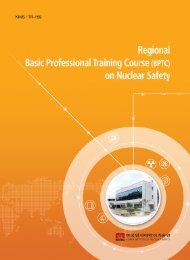PROSPER guidelines - Nuclear Safety and Security - IAEA
PROSPER guidelines - Nuclear Safety and Security - IAEA
PROSPER guidelines - Nuclear Safety and Security - IAEA
You also want an ePaper? Increase the reach of your titles
YUMPU automatically turns print PDFs into web optimized ePapers that Google loves.
It is recommended that utilities or NPPs conduct their own self-assessment of the<br />
effectiveness of their operational experience processes. The <strong>IAEA</strong>-led <strong>PROSPER</strong> team can<br />
then review the effectiveness <strong>and</strong> comprehensiveness of the plant self-assessment <strong>and</strong> offer<br />
comments <strong>and</strong> recommendations to further enhance the conclusions of the self-assessment.<br />
<strong>IAEA</strong>-led <strong>PROSPER</strong> missions compare, as far as possible, the operational experience<br />
processes for an NPP with guidance <strong>and</strong> equivalent good practices. These are based on<br />
guidance on safety practices produced by the <strong>IAEA</strong> <strong>and</strong> other international organizations <strong>and</strong><br />
the expertise of the <strong>PROSPER</strong> members themselves.<br />
<strong>PROSPER</strong> missions are process performance related in that they accept different approaches<br />
to the implementation of operational experience processes, depending on the organization of<br />
the NPPs. Recommendations are made on items of direct relevance to operational safety<br />
performance. Suggestions made may enhance the effectiveness of the operational experience<br />
processes <strong>and</strong> may also stimulate the NPP staff to consider other ways <strong>and</strong> means of<br />
improving it. Commendable good practices identified should be communicated to other<br />
utilities or NPPs for improvement consideration.<br />
The findings of the <strong>PROSPER</strong> mission are formally reported to the utility management along<br />
with the corrective actions agreed by the NPP. It is suggested that, at the request of the<br />
operating organization or member state, an <strong>IAEA</strong>-led Follow-up review mission is conducted<br />
within 18 months of a full <strong>PROSPER</strong> mission. The <strong>IAEA</strong>-led <strong>PROSPER</strong> Follow-up review<br />
mission will review the progress achieved by the plant in implementing the agreed<br />
recommendations made by the mission <strong>and</strong> also in correcting the deficiencies identified<br />
through the self-assessment. This evaluation will determine the effectiveness of those actions<br />
in improving the operational safety performance processes.<br />
The present <strong>guidelines</strong> are intended to assist members of an NPP or utility self-assessment<br />
team to identify <strong>and</strong> acquire the information relating to the self-assessment of their operational<br />
experience process, which they require to conduct a satisfactory assessment. These <strong>guidelines</strong><br />
are intended to promote thought, rather than be prescriptive.<br />
Section 2 of these <strong>guidelines</strong> gives guidance aimed at assisting the utility or plant in<br />
conducting a satisfactory self-assessment on the effectiveness of their operational experience<br />
review process. Section 3 details the logistics of preparing, conducting <strong>and</strong> reporting the<br />
<strong>PROSPER</strong> mission process. Section 4 gives guidance aimed at assisting <strong>IAEA</strong>-led <strong>PROSPER</strong><br />
team members in conducting the <strong>PROSPER</strong> mission.<br />
2.1. OBJECTIVE<br />
4<br />
2. GUIDELINES FOR THE DEVELOPMENT OF A PLANT<br />
SELF-ASSESSMENT REPORT ON THE EFFECTIVENESS OF ITS<br />
OPERATIONAL EXPERIENCE PROCESS<br />
It is recognised that it is important to include into operational safety performance experience<br />
review process all operational experience information to ensure that unknown/unrecognised<br />
safety implications do not go undetected <strong>and</strong> therefore the term operational experience<br />
process will be used. A flowchart of a typical operational experience process is shown in<br />
Fig. 3.<br />
Every utility/NPP should have its own operational experience process. This OE process<br />
should encompass internal <strong>and</strong> external experience <strong>and</strong> should be able to incorporate the<br />
consequent lessons learned, in order to enhance the operational performance of the plant.
















